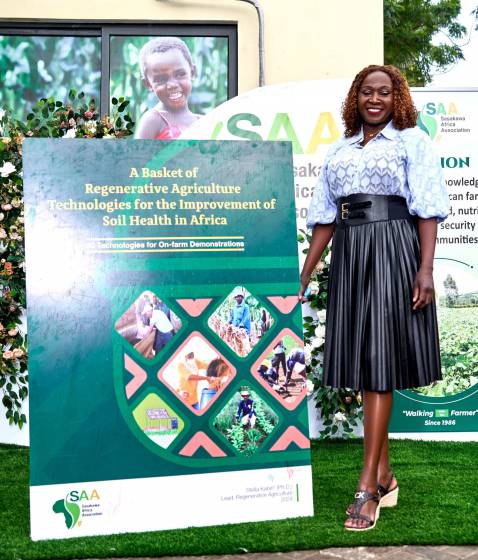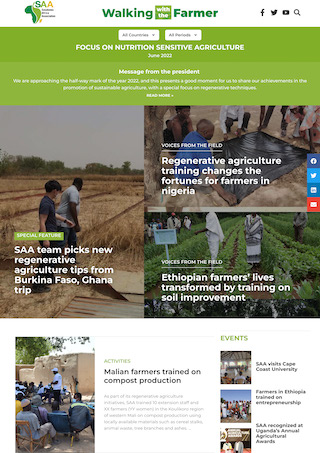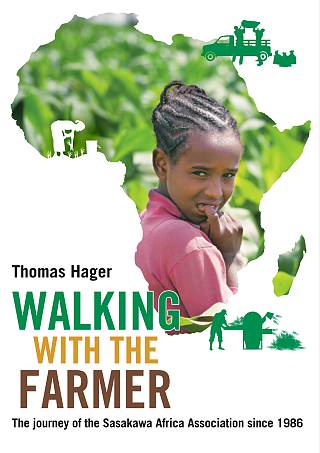Dr. Stella Kabiri’s Journey: Authoring A Basket of Regenerative Agriculture Technologies for the Improvement of Soil Health in Africa

Dr. Stella Kabiri, the Lead for Regenerative Agriculture at SAA since 2022, shares her inspiring journey as the author of A Basket of Regenerative Agriculture Technologies for the Improvement of Soil Health in Africa. In an insightful interview with Mrs. Ethiopia Tadesse, SAA’s Head of Communication and Advocacy, Dr. Kabiri reflects on her motivations, challenges, and aspirations in creating a book that has become a vital resource for farmers and agricultural practitioners across Africa.
A highly accomplished scientist, Dr. Kabiri holds a PhD in Production Ecology and Resource Conservation from Wageningen University, alongside advanced degrees in Geoinformation Science, Earth Observation, and Agriculture. Her extensive career includes scaling climate-smart agricultural technologies, promoting sustainable nutrient use, and conducting research focused on achieving negative carbon emissions in plant nutrition.
In addition to her role at SAA, Dr. Kabiri contributes to several continental initiatives, including the Soil Initiative for Africa and TERRA Africa, where she plays a key role in developing and disseminating regenerative agriculture technologies tailored for Africa. Her passion for sustainable farming and dedication to empowering farmers shine throughout the interview, offering readers valuable insights into the transformative potential of regenerative agriculture on the continent.
The Inspiration Behind Writing the Book on Regenerative Agriculture
Dr. Kabiri’s passion for regenerative agriculture was sparked by the challenges farmers face in maintaining soil health. Let’s hear about the inspiration behind her decision to write a book on this important topic.
Question: What Inspired You to Write a Book on Regenerative Agriculture Technologies?
In farming communities, the term “regenerative agriculture” often sparks curiosity but remains poorly understood. Many languages lack a direct translation, and its explanations can be overly complex.
At SAA, we identified soil health as the foundation of regenerative agriculture. Despite significant efforts to improve farming practices, yields often plateaued due to degraded soils unresponsive to fertilizers and good agronomic practices. Recognizing this, we prioritized empowering farmers to restore soil vitality.
The book was born from a desire to simplify these complex concepts. It serves as a hands-on guide for extension agents to help farmers improve soil health, ensuring productivity and sustainability. My hope is to provide farmers with practical tools to sustain their farms, thrive in their efforts, and build a legacy of resilience.
Exploring Key Regenerative Agriculture Technologies in the Book
In her book, Dr. Kabiri features a diverse range of regenerative agriculture technologies that address critical challenges faced by African farmers. Here, she discusses some of the key technologies and their impact on soil health.
Question: What Are Some Key Regenerative Agriculture Technologies Featured in the Book?
The book presents 50 regenerative agriculture technologies tested across Sub-Saharan Africa, including in Mali, Uganda, Nigeria, Ethiopia, and Ghana. These solutions blend indigenous knowledge with modern science, addressing soil health, water efficiency, and climate challenges.
Each technology is detailed in step-by-step guides, ensuring accessibility for diverse farming contexts. For instance, SAA’s Farmer Learning Platforms are highlighted as spaces where farmers experiment with and adapt these practices, fostering long-term soil stewardship and productivity.

The Role of Regenerative Agriculture in Enhancing Food Security and Sustainability
Regenerative agriculture not only improves soil health but also contributes to food security and sustainability. Dr. Kabiri shares how the technologies featured in her book help address these crucial issues in Africa.
Question: How Do These Technologies Contribute to Food Security and Sustainability in Africa?
Regenerative agriculture technologies empower farmers to manage resources sustainably, reducing dependency on external inputs while enhancing productivity. By integrating traditional wisdom with modern innovations, the book offers locally relevant solutions.
These practices not only improve crop yields but also preserve ecosystems, reduce emissions, and build resilience to climate change. The result is a thriving agricultural sector that secures food for today and protects resources for future generations.
Overcoming Challenges in Compiling the Book on Regenerative Agriculture
The journey of writing a book is never without its challenges. Dr. Kabiri reflects on some of the hurdles she faced in compiling the book and how she overcame them.
Question: What Challenges Did You Face While Compiling the Book?
The journey was not without hurdles. Africa’s diverse farming systems, climates, and soils made it challenging to select adaptable technologies. Bridging scientific advancements with local practices required extensive research, and simplifying complex concepts into practical guidance for farmers was an ongoing challenge.
Despite these obstacles, the process was immensely rewarding. The final product is a practical, scalable resource that equips farmers across the continent with impactful solutions.
The Influence of Agricultural Experience on the Book's Approach
Dr. Kabiri’s extensive background in agriculture deeply influenced her approach to the book. Here, she explains how her experiences shaped the practical, farmer-friendly advice in the book.
Question: How Has Your Background in Agriculture Influenced Your Approach?
My journey began with farmers living hand-to-mouth, reliant on the land but unable to sustain its fertility. Over the years, I’ve witnessed the transformation of African agriculture, with farmers increasingly engaging in the monetary economy.
This experience shaped my approach to the book. It bridges advanced agricultural knowledge with the realities farmers face—unpredictable weather, limited resources, and immediate needs. My goal was to make regenerative agriculture practices both accessible and impactful.
The Most Fulfilling Aspect of Writing the Book
Writing a book is a labor of love, and for Dr. Kabiri, the most rewarding part has been the impact it has on farmers. She shares what has brought her the greatest sense of fulfillment.
Question: What Has Been the Most Rewarding Part of Writing This Book?
Empowering farmers and extension agents with practical knowledge has been the most fulfilling aspect. Hearing success stories of farmers restoring their soils, boosting yields, and building resilience reaffirms the value of this work.
Knowing that this book can transform lives and communities is deeply gratifying. It represents a step toward a future where sustainable agriculture thrives, and farmers feel equipped to succeed.
Balancing Professional, Personal, and Writing Responsibilities
Balancing professional duties with personal life and the demands of writing a book is no small feat. Dr. Kabiri reveals how she managed to juggle all her responsibilities while completing this important work.
Question: How Did You Manage to Balance Your Professional and Personal Duties with the Time and Effort Needed to Write This Book?
I used a routine called “Salami Slicing.” This method involves breaking the writing process into small, manageable tasks and tackling them consistently over time. Instead of trying to write large sections at once, I focused on completing a “slice” each day, be it a paragraph or a concept. Usually, the “Salami” was the RA technology.
This approach helped me stay productive without feeling overwhelmed, even on busy days. It also allowed me to maintain momentum and ensure steady progress while managing my work and family commitments. By slicing the task into smaller pieces, I was able to juggle my responsibilities while staying focused on the bigger picture of creating a resource to empower farmers and extension agents.
Support from my colleagues, family, and friends also played a huge role. They encouraged me, provided feedback, and helped me stay motivated throughout the process. Additionally, my professional work in agriculture inspired much of the content, making the writing process feel like an extension of my daily efforts to promote sustainable farming.
The Support System Behind the Book's Creation
Writing a book is a collaborative effort, and Dr. Kabiri was fortunate to have a strong support system along the way. Let’s hear about the people who helped her throughout this journey.
Question: Who Supported You During This Journey?
This book is a testament to collaboration. I am deeply grateful to Prof. Kofi Boa of the Centre for No-Till Agriculture for his exceptional training and to Dr. Makoto Kitanaka, SAA’s president, for his encouragement.
The SAA RA Task Force and Communications Team provided invaluable critiques and visuals, while the Strategic Partnerships Office supported the journey. Special thanks to Ethiopia Tadesse and Sayako Tokusue for ensuring the book’s quality. Together, we created a resource that will leave a lasting impact on farmers and communities.
The Desired Impact and Legacy of the Book
Dr. Kabiri hopes her book will have a lasting impact on farmers, policymakers, and the agricultural community. Here, she shares the legacy she hopes to create.
Question: What Impact Do You Hope the Book Will Have?
The book aspires to bridge the gap between knowledge and action. For farmers, it offers practical, adaptable guidance to rebuild soil health and improve productivity. For policymakers, it highlights regenerative agriculture’s potential to address soil degradation, water scarcity, and climate resilience.
Ultimately, the book promotes collaboration and innovation, fostering a sustainable agricultural sector that thrives in the face of challenges.
Advice for Aspiring Contributors to the Agricultural Sector
As someone deeply invested in agriculture, Dr. Kabiri has valuable advice for those eager to make their own contributions to the sector. She offers words of wisdom for aspiring change-makers.
Question: What Advice Would You Give to Others Who Are Passionate About Contributing Their Knowledge to the Agricultural Sector?
My advice to those passionate about contributing their knowledge to the agricultural sector is to stay grounded in the realities of farming and focus on practical, farmer-centric solutions. Understand the challenges faced by farmers, including resource limitations, climate variability, and market access, and tailor your work to address these needs.
Engage with diverse stakeholders—farmers, extension agents, policymakers, and researchers—and value their insights and experiences. Collaboration is key to creating impactful and sustainable solutions. Be open to learning from others, as agriculture is a dynamic field that requires constant adaptation and innovation.
When sharing knowledge, prioritize simplicity and accessibility. Complex ideas should be broken down into actionable steps that farmers and practitioners can easily adopt. Strive to bridge the gap between advanced research and real-world application.
Finally, be persistent and patient. Transforming the agricultural sector takes time, and meaningful change happens through consistent effort and commitment. Stay passionate about your vision, but remain flexible in your approach, as success often comes from adapting to challenges and opportunities along the way.
Future Plans for Advancing Regenerative Agriculture
Looking ahead, Dr. Kabiri remains committed to advancing regenerative agriculture across Africa. Here, she shares her plans for continuing this important work.
Question: Looking Ahead, How Do You Plan to Continue Your Work in Regenerative Agriculture?
Looking ahead, I plan to continue my work in regenerative agriculture by focusing on scaling up practical, farmer-friendly solutions that promote soil health, water conservation, and climate resilience. This includes expanding outreach efforts through farmer learning platforms, demonstration plots, and digital tools to ensure more farmers have access to regenerative practices.
I aim to strengthen collaboration with researchers, policymakers, and extension agents to bridge the gap between scientific advancements and on-the-ground application. By working together, we can create strategies that are both effective and sustainable, tailored to the diverse needs of farmers across Africa.
In addition, I will focus on advocating for policies that support regenerative agriculture, particularly those that incentivize sustainable farming practices and invest in community-led initiatives. Ensuring farmers are included in policy discussions will remain a priority.
Lastly, I plan to contribute to knowledge sharing by publishing research, practical guides, and case studies that document successful approaches in regenerative agriculture. This will help inspire others and provide a foundation for future innovations in the field. My goal is to continue empowering farmers, improving productivity, and fostering long-term sustainability in agriculture.
Key Takeaways for Readers
Dr. Kabiri’s book not only provides knowledge but also inspires readers to take action. Here, she reflects on the key message she hopes readers will carry with them.
Question: What Message Would You Like Readers to Take Away from Your Book?
One day, my 7-year-old son came up to me and asked, "What’s your name?"
"Stella," I replied.
Then he pointed to his nose and asked, "What’s this?"
"Nose," I said.
Next, he held out his empty palm and asked, "What’s in my hand?"
"Nothing," I answered.
With a cheeky grin, he told me, "Now say it all together."
So I did: "Stella nose nothing!"
That’s when I realized I had walked straight into his clever little joke!
It's still a learning process, and we certainly don't have all the answers. As the climate changes, resources become scarcer, populations grow, and the policy landscape shifts, it often feels like we know very little. But together, through collaboration and shared efforts, we can figure it out and find solutions that work now and for future generations.
Dr. Stella Kabiri’s reflections highlight the importance of collaboration, persistence, and practical solutions in agriculture. Her book stands as a testament to her dedication to empowering farmers and driving sustainable change. Through her journey, she inspires others to contribute to the agricultural sector, ensuring that the future of farming is both sustainable and resilient.
Related article: Africa’s Soil Rebirth: SAA Launches Regenerative Agriculture Blueprint in Uganda
Related article: Book Launch: “A Basket of Regenerative Agriculture Technologies for the Improvement of Soil Health in Africa: 50 Technologies for On-Farm Demonstrations”
SAA Publications

E-newsletter
"Walking with the Farmer"
SAA publishes a bimonthly e-newsletter reporting on SAA activities.

SAA history book
"Walking with the Farmer: The journey of the Sasakawa Africa Assoication since 1986"
This book chronicles the history of SAA from its inception to the present.

Annual Report
Annual Report FY2023
Annual Report FY2023 is available here.




